Welcome to Visual Creativity
Welcome to SocialSight's comprehensive guide to mastering AI image prompts! In the rapidly evolving world of AI, the ability to generate unique and compelling visuals is an incredible asset. Whether you're a marketer, designer, content creator, or just curious about AI's creative power, this guide series will equip you with the knowledge to turn your textual ideas into breathtaking images using tools like SocialSight's very own Free AI Image Generator.
What Exactly are AI Image Prompts?
AI image prompts are textual descriptions or instructions you provide to an Artificial Intelligence model. Think of them as detailed instructions for a digital artist. The AI (like the one in the SocialSight Image Generator) analyzes your prompt to understand the subject, style, environment, and a myriad of other details you want to see in the final image. The more specific and thoughtfully constructed your prompt, the more accurately the AI can translate your vision into a unique piece of art.

A sophisticated neural network interpreting a complex artistic idea, transforming text into visual art, glowing pathways of data, digital art, vibrant indigo and purple hues.Why Effective Prompts Are Your Superpower
Why not just type "a cool car" and see what happens? While simple prompts can yield interesting results, mastering the art of prompting gives you unparalleled control and creative freedom. It's the difference between a random snapshot and a carefully composed photograph. Effective prompts allow you to:
- Achieve Specificity: Get the exact scene, character, or style you envision.
- Enhance Quality: Guide the AI towards more detailed, coherent, and aesthetically pleasing results.
- Save Time: Reduce the number of iterations needed to get your desired image.
- Unlock Unique Styles: Combine elements in novel ways to create visuals that stand out.
- Boost Creativity: Experimenting with prompts can itself be a source of new ideas and artistic directions.
At SocialSight, we understand the power of clear communication – it's what drives our social listening insights. The same principle applies when 'talking' to an AI.
The Anatomy of a Great Prompt
A powerful prompt often weaves together several key components. Let's break them down. Understanding these will help you construct detailed requests for the SocialSight AI Image Generator and other AI art tools.
1. The Subject: Your Core Idea
This is the main focus of your image – the person, animal, object, or concept you want to depict. Be as specific as possible to guide the AI accurately.
- Instead of cat, try a fluffy Siamese cat with blue eyes.
- Instead of car, try a vintage 1967 Ford Mustang, cherry red, convertible.
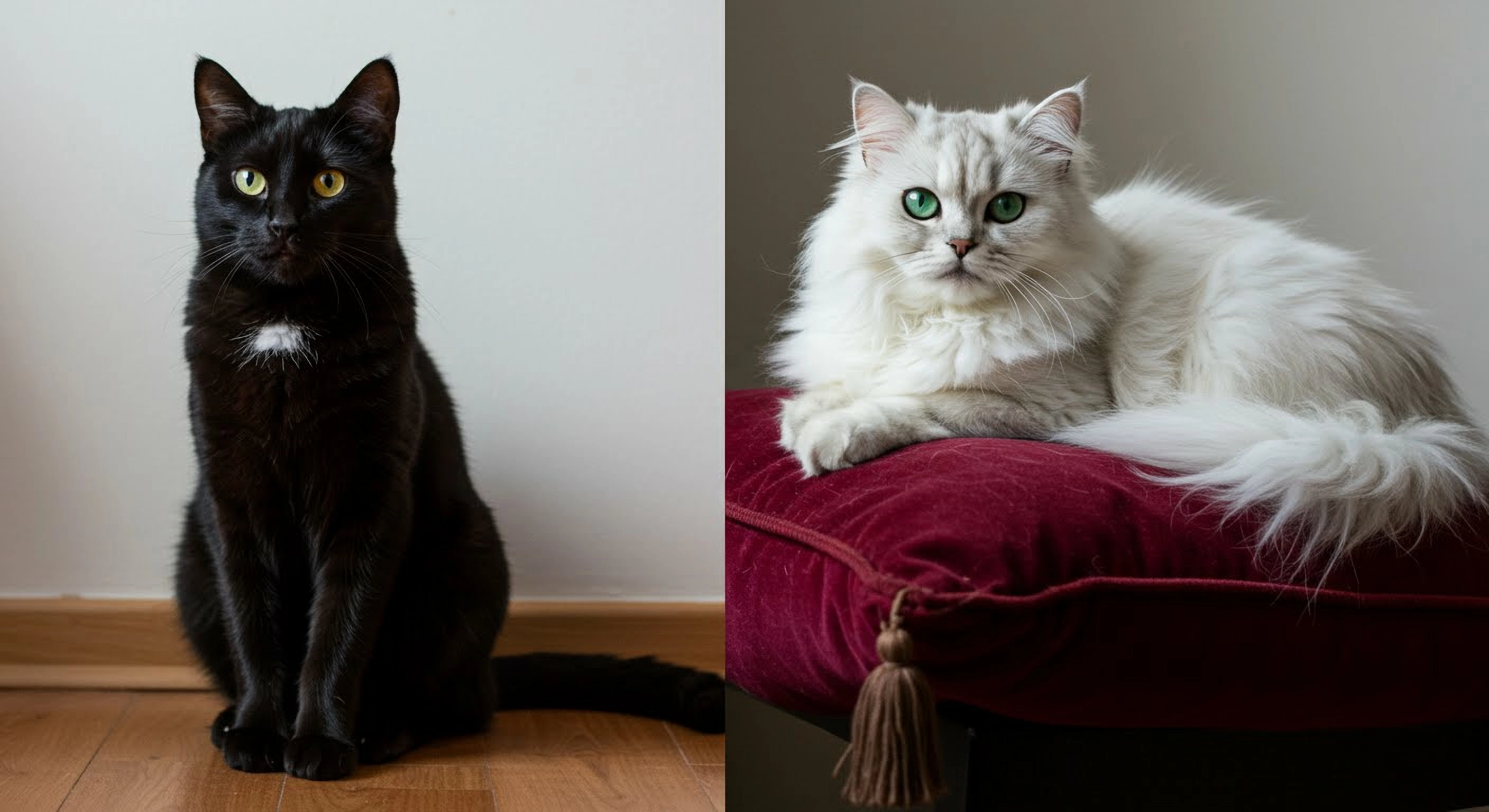
Side-by-side: left 'a cat', right 'a fluffy Persian cat with emerald green eyes, lounging on a velvet cushion, regal pose'2. Medium/Format: The Canvas of Your Vision
Specify the artistic medium or format you want the AI to emulate. This sets the overall texture and presentation style.
- Photography: DSLR photo, analog film photograph, Polaroid, wildlife photography, macro shot.
- Painting: oil painting, watercolor painting, acrylic on canvas, impressionist painting, abstract painting.
- Illustration: digital illustration, pen and ink sketch, children's book illustration, vector art, comic book art.
- Digital & 3D: 3D render, CGI, voxel art, pixel art, glitch art.
- Other: sculpture (clay, bronze, marble), blueprint, embroidery, stained glass.
3. Style/Aesthetic: Defining the Look & Feel
This refers to a specific artistic movement, genre, or visual characteristic that defines the overall aesthetic.
- Art Movements: Impressionism, Cubism, Surrealism, Art Nouveau, Art Deco, Pop Art, Renaissance, Baroque.
- Genre Aesthetics: Cyberpunk, Steampunk, Solarpunk, Fantasy, Sci-Fi, Gothic, Minimalist, Vintage, Retro (e.g., 80s retro wave).
- Descriptive Aesthetics: ethereal, dreamlike, gritty, whimsical, brutalist, ornate.
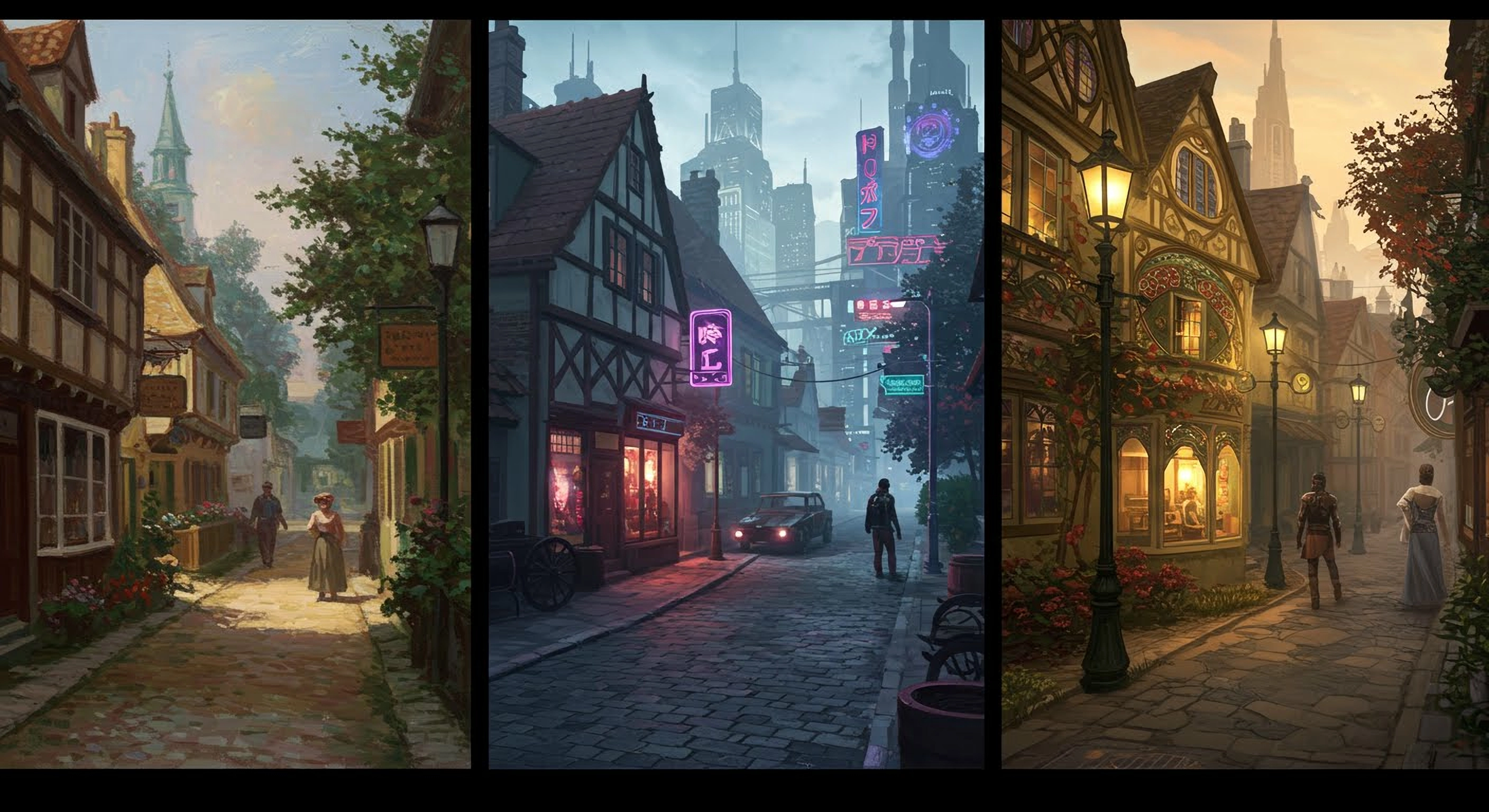
A quiet village street, depicted in the styles of: Impressionism, Cyberpunk, and Art Nouveau --grid4. Artist Influence: Learning from the Masters
You can guide the AI by referencing the style of well-known artists. This helps the AI adopt particular techniques, color palettes, and compositional approaches associated with that artist.
- Examples: in the style of Van Gogh, cinematic lighting like Ridley Scott, character design by Hayao Miyazaki, landscape photography by Ansel Adams.
- Ethical Note: While referencing artists can be a powerful tool, especially for historical figures, be mindful of the ongoing discussions regarding AI and contemporary artists. At SocialSight, we encourage respecting intellectual property and creative originality.
5. Action/Verb/Pose: Bringing Subjects to Life
Describe what your subject is doing or its posture. This adds dynamism and narrative to your image.
- a knight bravely fighting a dragon
- a woman thoughtfully gazing out a window
- a cat peacefully sleeping in a sunbeam
- dynamic action pose
6. Environment/Setting: Crafting the Scene
Define the background, location, and overall context. This helps ground your subject and tell a more complete story.
- in a bioluminescent underwater cave
- atop a snow-capped mountain at sunrise
- inside a cozy, cluttered bookstore filled with curiosities
- on a bustling alien marketplace on a desert planet
7. Lighting: Setting the Mood
Lighting is crucial for realism, drama, and atmosphere. Specify the type, direction, intensity, and color of light.
- cinematic lighting
- dramatic volumetric lighting (god rays)
- soft golden hour light
- eerie moonlight
- bright studio lighting
- neon glow
- rim lighting (backlighting that outlines the subject)
8. Color Palette: Painting with Emotion
Specify particular colors, color relationships, or an overall color mood to evoke specific feelings or aesthetics.
- vibrant rainbow colors
- monochromatic blue tones
- warm earthy autumn palette
- cool cyberpunk neons (pink, cyan, purple)
- sepia tone for a vintage feel
- high contrast black and white
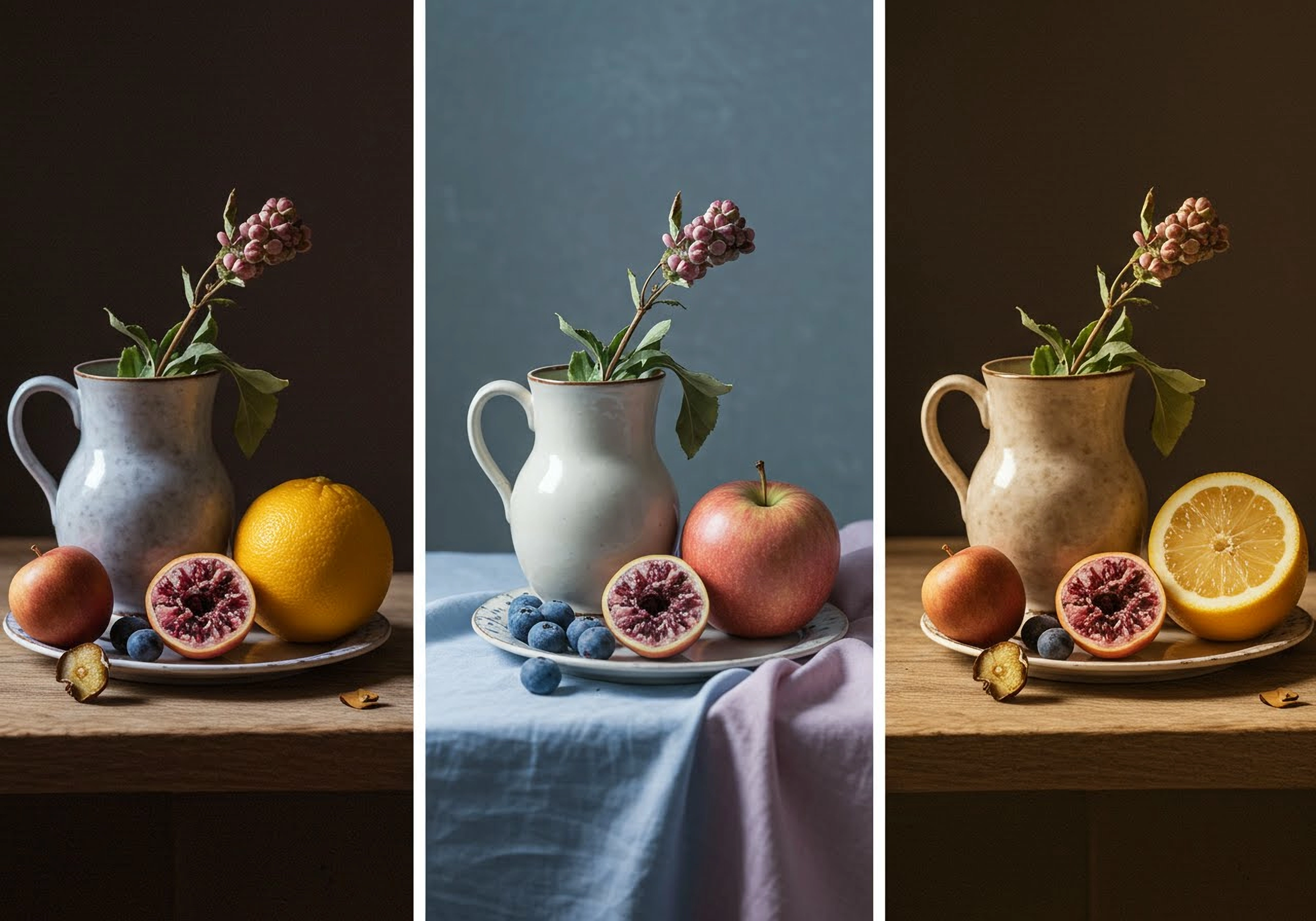
Identical still life composition, one with 'vibrant primary colors', another with 'muted pastel colors', and a third with 'monochromatic sepia tones' --grid9. Composition/Framing: Directing the Eye
How are the elements arranged in the frame? This guides the viewer's focus and the overall impact of the image.
- close-up portrait
- extreme wide shot landscape
- full body shot
- medium shot
- macro (extreme close-up)
- bird's-eye view (top-down)
- low-angle shot (looking up)
- Dutch angle (tilted)
- rule of thirds
- leading lines
- symmetrical composition
10. Detail & Complexity: Adding Richness
Specify the desired level of detail, texture, and intricacy.
- hyperdetailed
- intricate patterns
- 8k resolution (conceptual for detail level)
- sharp focus
- minimalist
- clean lines
- rough textures
- smooth and polished
11. Mood & Atmosphere: Evoking Feelings
What emotional tone or overall feeling do you want the image to convey?
- serene and tranquil
- dark and ominous
- joyful and whimsical
- mysterious and enchanting
- epic and majestic
- nostalgic and melancholic
12. Negative Prompts: Refining by Exclusion
Some AI image generators allow you to specify what you *don't* want to see. This is incredibly useful for removing unwanted elements, styles, or common AI artifacts.
- Examples: --no text, --no blur, --no ugly, --no watermark, avoiding distorted hands, not cartoony, no extra limbs.
13. Aspect Ratio: Shaping Your Canvas
The aspect ratio determines the shape of your image (e.g., square, widescreen, portrait). While often set via UI controls (coming soon to SocialSight's Image Generator), some models might accept keywords like 16:9 aspect ratio or square image in the prompt itself, or through parameters like --ar 16:9.
Explore Styles: Dive Deeper with Our Guides
This anatomy provides a solid foundation. But the real magic begins when you start specializing! SocialSight has curated a series of "Ultimate Guides" dedicated to popular and fascinating styles and techniques. Whether you want to achieve breathtaking photorealism, conjure epic fantasy scenes, or design cute illustrations, we've got a guide for you.
You'll find these guides linked in our navigation and throughout our platform. Each one is packed with specific keywords, examples, and tips to help you master that particular aesthetic using the SocialSight AI Image Generator.
Expert Tips for Better Prompts
- Be Specific, Yet Concise: Provide enough detail for clarity, but avoid overly long or convoluted sentences. Find the sweet spot.
- Iterate and Experiment: Your first prompt is rarely your last. Use SocialSight's Free AI Image Generator as your playground. Generate an image, see what you get, refine your prompt, and try again. Each iteration is a learning opportunity.
- Use Strong, Evocative Keywords: Adjectives and descriptive adverbs are your best friends. Instead of 'sad man', try 'a melancholic man with weary eyes, gazing at a rain-streaked window'.
- Combine Concepts Creatively: Don't be afraid to mix and match! 'A steampunk owl delivering mail in a futuristic city' can lead to wonderfully unique results.
- Word Order Can Influence Results: Some AI models give more weight to words appearing earlier in the prompt. Experiment with phrasing.
- Break Down Complex Scenes: For very complex images, you might mentally (or literally) list out the key components—subject, background, foreground elements, specific objects—and ensure your prompt addresses them.
- Learn from the Community (and SocialSight!): See what prompts others are using. At SocialSight, we analyze trends in social conversations to understand what resonates. Apply that curiosity to AI art communities to see effective prompting in action.
- Save Your Successes: When you craft a prompt that yields an amazing result or a unique style, save it! Build your own library of effective prompts.
- Understand Your Tool's Nuances: While these principles are broadly applicable, every AI model (including the one in SocialSight's generator) might have slight quirks or respond better to certain phrasing. Experimentation is key!
Ready to Unleash Your Creativity?
Armed with these prompting fundamentals, you're all set to explore the limitless possibilities of AI image creation. Start generating your unique visuals today!
Try SocialSight's Free AI Image Generator!Ultimate Style Guides

Ultimate Guide to Photorealistic AI Prompts
Learn to craft AI prompts that generate hyperrealistic images. Explore camera emulation, lighting, textures, and advanced techniques with SocialSight's guide.
Read Guide →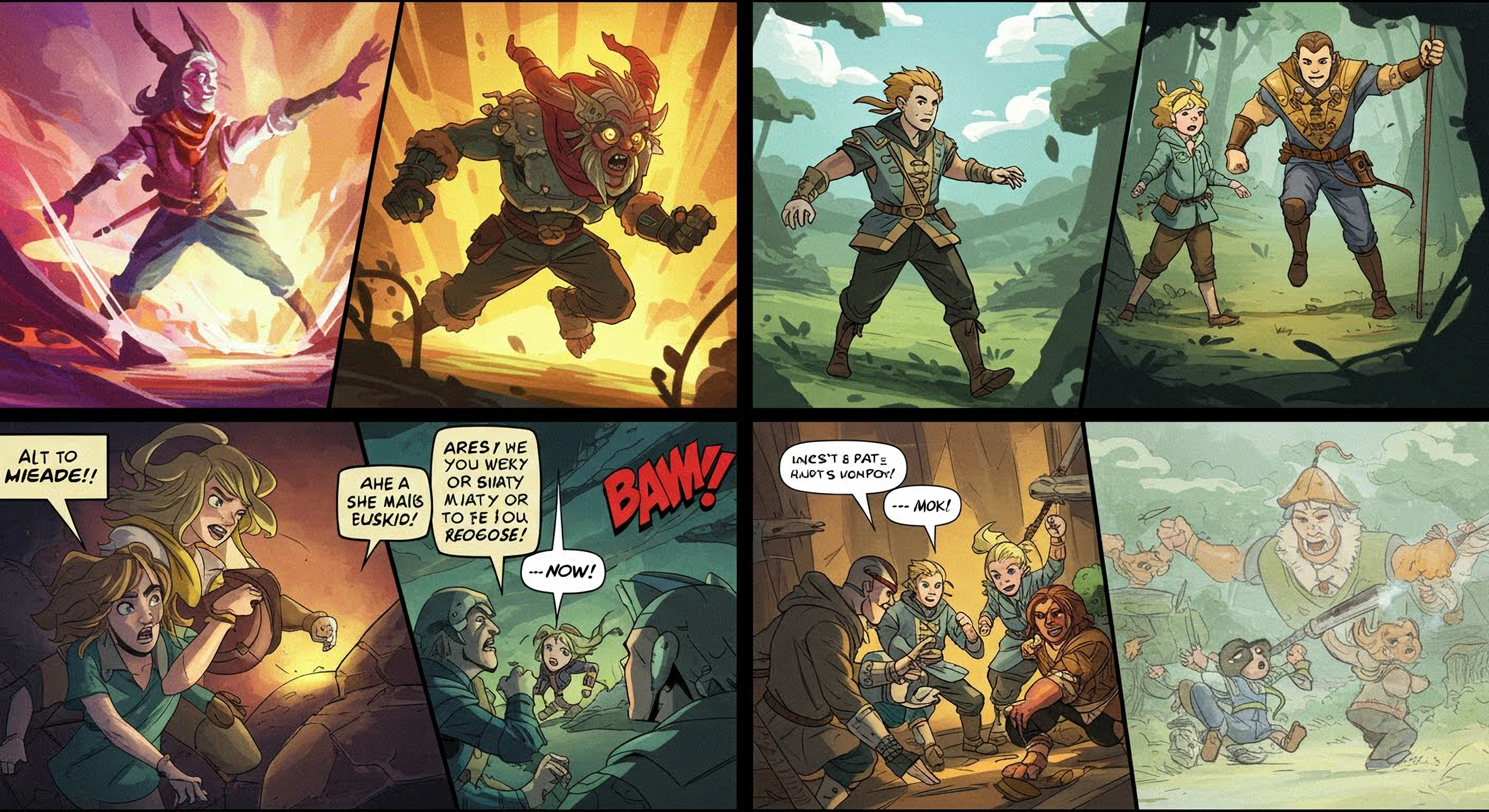
Ultimate Guide to AI Illustration Styles
Dive into diverse AI illustration styles with SocialSight! Master digital painting, vector art, comic book aesthetics, watercolor, ink sketches, and more with our free AI Image Generator.
Read Guide →
Ultimate Guide to AI Logo Generation Prompts
Learn to craft effective AI prompts for unique and professional logo designs. Master styles, colors, iconography, and more with SocialSight's guide for our free AI Logo Generator.
Read Guide →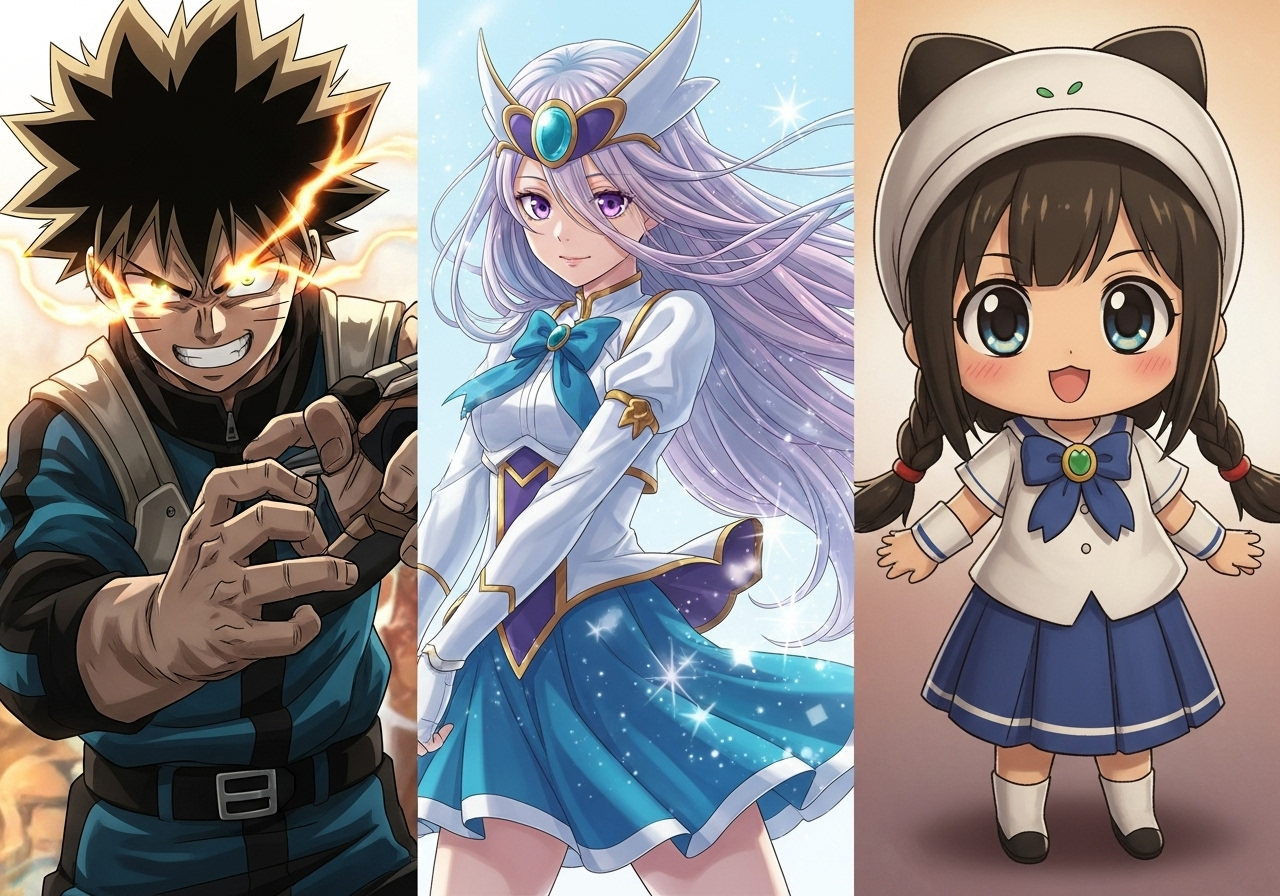
Ultimate Guide to AI Anime Generation Prompts
Learn to craft effective AI prompts for unique and captivating anime scenes and characters. Master styles, settings, character design, and more with SocialSight's guide for our free AI Anime Generator.
Read Guide →